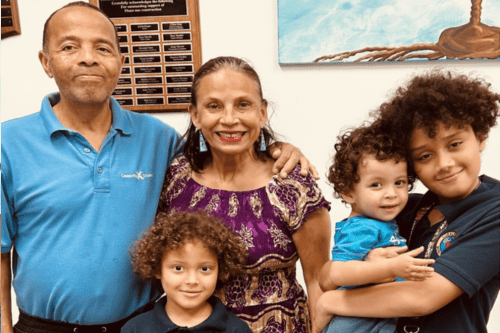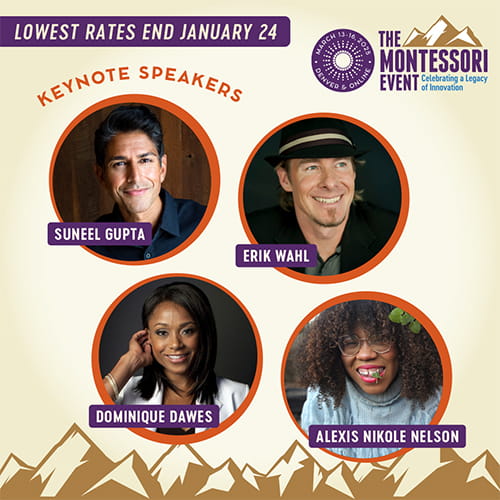Taking a Closer Look at Hispanic Heritage: An Interview With Dr. Lucy Golden

Dr. Lucy Golden with her husband Victor Rafael, and their grandchildren from left to right; Orion Sky, Baby Ocean Matias, and Nakai Paz.
In my work at AMS as the director of equity and engagement, I find the most joy in uplifting voices and perspectives that are typically tone-policed, muted, or otherwise targeted. Dominant narratives are everywhere, it's in the very air that we breathe. I find that the best use of my time and talent is in unearthing views that go unheard. Striving towards liberation is my process as an educator and equity practitioner.
Recently, I had the honor of sitting with Dr. Lucy Golden, co-founder and co-executive director at Coral Reef Montessori Academy Charter School in Miami, Florida to hear some of her thoughts on Hispanic heritage and how schools can enhance their work by amplifying the Black-Indigenous voices that have been marginalized for far too long.
Dr. Lucy Canzoneri-Golden is the co-founder/co-director of Coral Reef Montessori Academy Charter School located in Miami Florida. Dr. Canzoneri-Golden is a pioneer in the field of teacher-led educational reform, providing a refreshing alternative to top-down, expert-led initiatives that dominate urban education today. Dr. Canzoneri-Golden began her teaching career in Harlem, New York at the Central Park East Schools under the leadership of Deborah Meler before relocating to Miami, Florida in 1988. Dr. Canzoneri-Golden has always sought out innovative techniques for teaching and learning. Dr. Canzoneri-Golden recently obtained a doctorate of education in Educational Leadership from Lynn University in Boca Raton, Florida. As with Montessori Education, culturally relevant pedagogy, and anti-bias, antiracist curriculum resonated profoundly with her; therefore, it was a natural progression for her and her business partner to join in doing researching and analyzing the perspectives of parents teachers and administrators on how culturally relevant pedagogy and anti-bias and antiracist curriculum operate in three urban public Montessori schools.
What are your thoughts about Hispanic Heritage Month and how it is approached in our schools?
Dr. Lucy Golden:

Talk to us about some of the problems as you see them.
Lucy:
Well, let's fast forward to the present of this whole identity of Latinidad and what that means. You know, there's so much controversy, just even calling ourselves Latinx. We do that for gendered purposes, so that makes sense. But even the word “Latin” implies folk of Latin origin, including the Romans, whose roots can be traced to Spain, France, Italy, and Portugal, where their languages have Latin roots.
Language is one thing, identity is another and includes how the two intermingle. We are not monolithic, it's really complicated because there are so many layers to it. However, the most important step in addressing these problems is recognizing the issue of anti-Blackness that exists in the Latino community. That is number one. If we don't recognize that, then we are just spinning our wheels and we're doing performative celebrations, without helping our children understand the complexities of their identity.
When we take an honest look at these perspectives, folks like myself, who identify within the Latinx community, begin to make admissions and realize that we have anti-Blackness and anti-Indigeneity in our ways of thinking and the way we were raised, our language, everywhere. Going back to what happened in Latin America, we see similarities in that indigenous people in the Caribbean were colonized by Europeans who imposed their religion, spread disease, and inflicted terror. People were assaulted, imprisoned, and cheated out of their land and culture. These events, though oversimplified here, are the reality.
The Europeans, who terrorized and took over countries in the Caribbean and Latin America had to find ways to continue to oppress in order to maintain their superiority. Unfortunately, many fell victim to this. While there are countries that still have thriving indigenous communities, although they've been marginalized and exploited, and they have been faced with the repercussions of white supremacy and colonial mentality, they’re alive and well. For example, in Colombia, where I was born, we have over 500 indigenous languages just in our territory. Some Indigenous communities are still there, so that’s one aspect of it.
So then what happened? The slave trade happened. This was a slightly different reality with the Spanish than the folk in the United States or England or in the Caribbean, but it was still exploitation. It’s not like it was any better, it just may have been different in some ways. The Spanish colonizers were not somehow nicer or better in terms of how they treated Black folk and enslaved people. They did it, and it's all evil; bottom line. Evil is evil, whether you do it speaking English or you do it speaking Spanish.
In order to maintain control, there was a conscientious effort in different countries in Latin America to mix the races, which is also a little different from the United States. Although we know that it happened in the U.S. as well, we also know how it happened. We are now left with this colorblind mentality in Latin America. Why? Because we're all mixed. So then you have sentiments like “Hey, I'm not prejudiced, my grandfather's Black, or my grandmother's indigenous.” “Hey, I'm not racist all of my cousins are dark-skinned.” “Hey, I can’t be racist, I'm married to an Afro-Latino.” False, false, and more false, because the whole concept according to many Afro-Latino historians, anthropologists, and sociologists, is that this is all intentional.
This is all very problematic, as we know, with the white liberals here in the United States who say, “I'm colorblind, this doesn't exist.” That even makes it more pathological. Right? Because if you see no evil, hear no evil, then how are we going to change this? How are we going to reverse this?
I personally continue to learn a lot from folks like Diaspora Dash, an Afro-Panamanian who is exploring the myth of Mestizaje, a term that refers to racial mixture. I have really tried. Now, as I'm in the process of learning and unlearning, to be very conscious of the pathology that exists within my body, the pathology that is within my consciousness, the pathology that exists within the generations of my family. I married an Afro-Latino, so his family was happy when he married me. For obvious reasons, right? In their eyes, this was a way to improve the race. However, my family, on the other hand, felt the opposite. What are you doing? We are supposed to be whitening and making the race better. I live this. I know this. My kids know this. My grandkids know this. Our people know this.
How can we, as educators, get beyond the pathology of colorblindness in the Latinx community and start to really talk about these issues?
Lucy:
At our school, when we have these celebrations that are part of the history curriculum– Latinx heritage in September and October, Indigenous history in November, and Black Heritage in February, etc., we see these as opportunities to really examine the complexities as it relates to colorblindness and colorism. We continue to grow in this work as a school community. Our school has a committee that looks specifically at these sorts of things and as a founder, I intentionally step back to give space for the younger generation of teachers and leaders to own this work. We have to continue to make sure that the anti-bias and antiracist components of our celebrations and education are centered and not forgotten or erased. We have to be vigilant and create norms that remind us that we cannot just center the Europeans. We have to center the Indigenous people.
Did you know that the vice presidents of Costa Rica, Epsy Campbell, and Colombia, Francia Márquez are Afro-Latinas? We need to teach our children these things. We simply won’t see this prominently shown on television. These are the things that we want our children to know because we see the anti-Blackness and the anti-Indigeneity and how parents and caregivers often check off the box that identifies their child as white, even though we clearly see they are Black and Indigenous. That's how they want the world to see that kid. We are asking, how can we reverse that? Because what we are saying to kids is being and/or looking white is better. So if you are ever given the choice, choose the white box.
We need to be able to constantly examine the pathology of anti-Blackness and anti-Indigeneity in Latin America. I think that is the number one focus. So how do you do that? Bring authentic and TRUE stories into our classrooms and schools. We all must ask ourselves, what am I doing to amplify Black and Indigenous voices? Let us do the research and not dismiss the pathology of white supremacy in our lives and in our realities. I’d say this is the biggest work that has to be done. I think that's the most important thing right now.
About the Author
 |
Maati Wafford (she/her) is the former director of equity and engagement for the American Montessori Society. For nearly two decades she has created brave spaces for Montessori educators to expand, build, and create more justice in the world. AMS credentialed (Early Childhood, Elementary I – II, Administrator). |
Interested in writing a guest post for our blog? Let us know!
The opinions expressed in Montessori Life are those of the authors and do not necessarily represent the position of AMS.
















